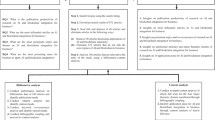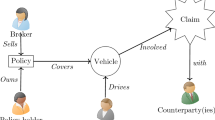Abstract
We collected Chinese food fraud events from 2001 to 2019, and initially established a database of 454 data sets based on China's national conditions. This database supplements the gaps in the internationally established economically motivated adulteration (EMA) database. Statistical results showed that the data reported by the media accounted for 71.6% of the total amount of food fraud information. Most fraud incidents were recorded in eleven product categories, e.g. agricultural products, wines, dairy and meat products. Product fraud (72.2%) was the first type ranked food fraud information.

Similar content being viewed by others
References
Bouzembrak Y, Marvin JPH (2016) Prediction of food fraud type using data from rapid alert system for food and feed (RASFF) and bayesian network modelling. Food Control 61:180–187
Cai HD, Wang WQ, Wen H, Xu YM, Shen LR (2019) Analysis and visualization of academic maps on economically motivated adulteration database of the center for food protection and defense, university of Minnesota, USA. J Food Saf Qual 10(24):8548–8555
Chen Y, Zhang JK, Ge YQ (2019) A bibliometric analysis on technology innovation of food authentication. J Food Saf Qual 10(24):8183–8194
Everstine K, Kircher A, Cunningham E (2013) The implications of food fraud. https://www.foodqualityandsafety.com/article/the-implications-of-food-fraud/
Food and Drug Administration (2009) http://www.gpo.gov/fds–ys/pkg/FR–2009–04–06/pdf/E9–7843.pdf
Gossner M-EC, Schlundt J, Embared BP, Hied S, Lo-Fo-Wong D, Beltran J, Tritscher A (2009) The melamine incident: implications for international food and feed safety. Environ Health Persp 117(12):1803–1808
Johnson R (2014) Food fraud and “economically motivated adulteration” of food and food ingredients. http://fas.org/sgp/crs/misc/R43358.pdf
Meng J, Niu B, Gu SQ, Deng XJ, Fang Z (2019) Application of proteomics technology based on liquid chromatography–mass spectrometry in food identification. J Food Saf Qual 10(4):998–1003
Spink J, Moyer CD, Park H, Wu Y, Fersht V, Shao B, Edelev D (2015) Introducing food fraud including translation and interpretation to Russian Korean, and Chinese languages. Food Chem 189(12):102–107
The Grocery Manufacturers Association (2010) Consumer product fraud, deterrence and detection. http://www.gmaonline.org/downloads/researchandreports/consumerpro–ductfraud.pdf
Tibola CS, Da Silva SA, Dossa AA, Patrício D (2018) Economically motivated food fraud and adulteration in Brazil: Incidents and alternatives to minimize occurrence. J Food Sci 1:12024
Wang WQ, Wen H, Zhang WZ, Zhao ZC, Zhao LR (2019) Analysis of global economically motivated adulteration and food fraud based on the EMA database of the United States pharmacopoeia. J Food Saf Qual 10(3):804–810
Yang J, Gao J, Miao H (2015) Discussion of food fraud and food adulteration. Food Ferment Ind 41(12):235–240
Zheng YN, Guo YH, CaoQian JH (2019) Application of liquid chromatography–mass spectrometry in food adulteration. J Food Saf Qual 10(23):7953–7958
Acknowledgements
We would like to thank the research staff for the hard work, and the authors thank Dr. Dawei Chen for his guidance on the structure of this paper. This work was funded by the Science and Technology Project of State Administration of Market Supervision (2020MK173).
Author information
Authors and Affiliations
Corresponding authors
Ethics declarations
Conflict of interest
All authors declare that they have no conflict of interest.
Additional information
Publisher's Note
Springer Nature remains neutral with regard to jurisdictional claims in published maps and institutional affiliations.
Rights and permissions
About this article
Cite this article
Li, H., Cheng, Y., Luo, J. et al. Establishment of a food fraud database and analysis of fraud information based on network data in China. J Consum Prot Food Saf 17, 177–181 (2022). https://doi.org/10.1007/s00003-021-01361-x
Received:
Accepted:
Published:
Issue Date:
DOI: https://doi.org/10.1007/s00003-021-01361-x




